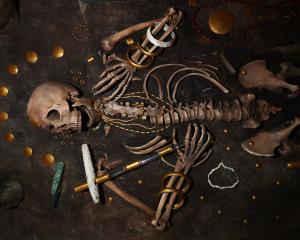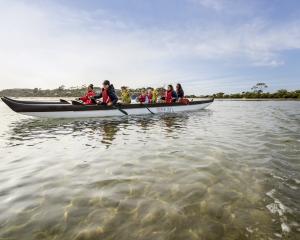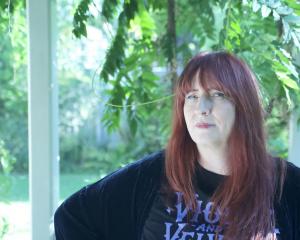Commemorations have recently marked 100 years since the death of Robert Falcon Scott. But what of the women left grieving, asks Zoe Young, granddaughter of the explorer's wife.
How many people can say that in the space of a week they watched four women play their grandmother on stage, and heard another on the radio? This has been my experience since I came to this island: to Oamaru in North Otago in particular, for commemorative events marking 100 years since news of the death of Robert Falcon Scott reached the world. It became an ancestral pilgrimage, you might say, a quest for resonance of the woman who encouraged and kept a diary for Captain Scott when he set off for the South Pole.
I came here from London, in the 100-year-old footsteps of my paternal grandmother, Kathleen Scott. She died in the 1940s, so we never met. Perhaps this is my way of getting to know her. My journey marks a century since this alluring, artistic and adventurous woman left my baby uncle Peter behind in London and voyaged here for a second time, intending to greet her husband returning from the pole.
As everybody now knows, Capt Scott and his polar party did not return. But as news spread and the world began to mourn in mid-February 1913, Kathleen was still far at sea in the Pacific.
''My wireless'', as she called it, didn't reach her for another week. Somewhere near Tahiti, she still wasn't due to arrive in Wellington for another week.
What could a new widow do but continue, and prepare herself to face the world on arrival.
In February 2013, I find myself wondering what that time was like. How did it feel for an independent-minded wife to lose her man like that? What impact has that very public bereavement and Scott's legend had on our families, on us as descendants of the women and children left behind? What of the women, who enable ''heroic'' expeditions to happen, raise funds, charm sponsors, deal with the press and when it all goes wrong become mourners, single parents, the focus of public attention and grief? Are these women not heroes, too?
Kathleen Scott carved statue after statue of her late husband, including the marble monument felled in the Christchurch earthquakes, now lying in state at the entrance to the Scott exhibition at Canterbury Museum. Kathleen was a passionate, private person, but she kept a diary, started for Capt Scott to read, which she continued after his loss. Once her wild writing can be deciphered, it tells something of her inner experience and determination to hold steadfast to their shared values through the storms.
My sister, the author Louisa Young, wrote the biography of our grandmother based on these diaries, letters and other sources, which are now kept in the Scott Polar Research Institute in Cambridge, England. Louisa entitled the biography A Great Task of Happiness: the Life of Kathleen Scott because cheerfulness was something Kathleen, an orphan, was determined to maintain.
Louisa knew that if she didn't write it when she did, that someone else probably would. And some of what has been said about our grandmother by others isn't fair or true. The fact she had a mind of her own and chose to associate with men has been held against her.
Perhaps it is understandable: she was an unusual woman for her time, and the wives of lost heroes rarely get it easy in the press. Certainly the woman who could catch and keep the heart of a driven man like Scott would be no shrinking violet. Her life story is impressive enough, though, surely.
Visiting New Zealand has provided some clues. I have learned just how close to myth my ancestors' stories are becoming. There are books, plays, songs, dances, even an opera in preparation. All feature my grandmother and her first husband, Capt Scott. Our family history has become entwined with the culture and myth-making of the British Empire, and especially so in New Zealand. Having been in the country a while, I begin to understand that this is a land to which everyone's ancestors came from far across the sea. This is a land where adventure is a way of life, an attractor for society. So our own 100-year-old ends-of-the-earth stories have an extra appeal and are everyone's to tell now, and retell.
And times have changed enough now that the stories are no longer just about the men, the martyrs to science and adventure, frostbitten in the snows. Now we hear tales about the women too. The romance, the families, the powers behind the men, the women left behind - Kathleen, Oriana Wilson, Hilda Evans and the rest. They picked up the pieces when their men were lost, they raised children schooled in similar values, and kept the heritage alive. I am part of that, a daughter from Kathleen's second marriage, to Hilton Young.
Here are some facts.
Orphan, sculptor, dancer and gypsy-hearted adventurer in her own right, my grandmother Kathleen was no tame or ordinary naval wife. Youngest of 11 children, part Scots and a quarter Greek, her maiden name was Kathleen Bruce. Convent-educated, she ran away to London, and then Paris, to study art. She chose classes in sculpture with Auguste Rodin. Soon he called her ''colleague''.
Her art, this figurative sculpture, became her life's work. She made small mother-and-child pieces (as pictured here), portraits and later, idealised boys, reaching to the stars. She loved dancing, men and babies - especially baby boys.
She worked with a local midwife on the quiet and although not sisterly to feminists, looked after her female friends. Pursing her lips at pregnancy out of wedlock, she shepherded the dancer Isadora Duncan through labour and all kinds of chaos.
Kathleen's friends were artistic, sometimes anarchistic, tending to be wild and free. Many were at the forefront of their fields: artists, writers, musicians, prime ministers, explorers. She taught George Bernard Shaw, in his 60s, how to dance.
Like her husband, she thrived on adventuring, simple living, swimming and tramping, sleeping outdoors when she could. On first meeting Con Scott, as his family called him, at a London society lunch, he commented on her sunburn. She'd been vagabonding, camping out in Greece, she said. How wonderful, he said, to vagabond like that.
They fell in love and she shook off her other suitors at last. Kathleen was nearing 30 - Con was 10 years older - and she had finally found a ''simple, rocklike'' hero, a father for her longed-for son.
As she sat pregnant, Kathleen Scott supported, indeed encouraged her husband in his bid to lead a new expedition to the pole. He announced his intention to go south again about the time she gave birth.
When he finally set off, their son was 9 months old, and he carried with him a note from his wife reminding him to do what he felt he needed to do, even at the expense of his life. She loved her husband, endlessly, but that meant loving his freedom as well as her own. Freedom for him to lead his men to the ends of the earth in Antarctica; and freedom for her, to sculpt, to earn, to dance, meet friends, be outdoors and to travel, and to be a mother to their son.
Peter Scott, Capt Scott's only son, grew into an Olympic sailing champion, and a father of 20th-century conservation through co-founding WWF. Her second son, my father, Wayland, wrote Eros Denied helping spread the sexual revolution, and in politics he worked with our mother for disarmament, against pollution and female genital mutilation.
Unusually for a woman of Kathleen's time and class, she not only decided to do as she wished, she decided to do it well. Avoiding scandal in a gender-stereotyped society was therefore not something she entirely managed. She loved travel, and riding: on horses, the prows of boats, and the front of trains. While her beloved Con Scott was away, she started to learn to fly. This didn't go down very well. In her diary, she records requests that she avoid any scandal while her man was away.
She was a devoted wife, and chaste, so why should she not do as she wanted, and have her own fun? She enjoyed interesting people's admiration - what neglected orphan would not? She left behind her 9-month-old baby to travel to New Zealand and see her husband off (from Lyttelton and Port Chalmers in November 1910). But even so, despite all her love, her loyalty, her support for her husband's expedition, our grandmother did worry that she might not be a good wife.
So she voyaged for a second time to New Zealand, in January 1913, making the difficult decision to leave little Peter in London once again. Capt Scott had died nearly a year before, and been found in November, but when she left London nobody knew. Kathleen planned to travel for six weeks and be there to greet her husband returning to New Zealand in March, then to travel home with him.
On her way across the globe in early 1913 she took the opportunity to meet friends and dance in New York, ride the engine of a train through the New Mexico desert and camp out with cowboys, riding horses in the bush.
Then, still not knowing her man was dead, she boarded a ship in San Francisco.
''This ship smells,'' she noted in the diary she'd kept for her husband all the while.
As Kathleen sailed hopefully across the Pacific, Scott's ship, Terra Nova, reached Oamaru in early February 1913, and sent two men ashore bearing news of his demise.
Amid much drama for a little town, the facts were smuggled to Christchurch in code, and passed to a sponsoring news agency in London to sell the world the news.
A week later, the wireless reached Kathleen's ship and, gradually, excerpts of his diary came through. His last words gave her great courage: she would follow his example, and not whine. By the time her ship docked in Wellington on February 27, 1913, half the world knew her husband's terrible tale.
A horde of press and sympathisers were waiting for ''the wife''.
She was greeted first by her brother Wilfrid, who had been on the Terra Nova with Scott, and then at the wharf by Edward Wilson's wife. She was, Kathleen said, ''behaving well, poor soul. Hers is courage indeed.''
In her diary at this time she quotes at length from Con's last letters, ''fine, stirring words of self-forgetfulness'' she describes them.
''We must be proud, and happy, and make our gratitude drown our pain.''
The diary then tails off, no further entries for almost five months. Nothing but mourning perhaps, combined with celebrating Scott's achievement, and protecting their son. Peter, the hero's son, became a press poster boy, the most famous boy in the world. To protect him and her sanity, she ran with a friend to far mountains. Later she travelled to North Africa, to the Sahara for some peace (she rode a camel, dressed as a boy).
And she shaped monuments to her lost beloved - bronze for London, and for Christchurch (never quite finished) in marble.
Our grandmother in mourning made sure she stayed busy, and cheerful, and bright, because that is what a woman like her did.












